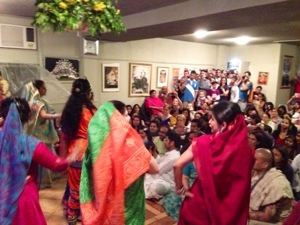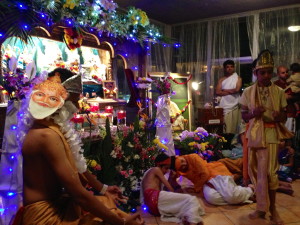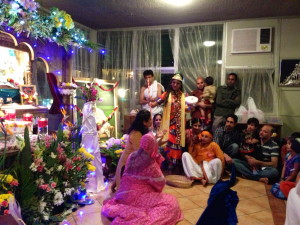So here is the famous, soon to be famous, Hare Krishna rapper Mikey Jay…
Krsnendu dasa: Alright everybody, I am very excited today to be interviewing the famous Mikey Jay who is as you will get to find out, is one of the world famous, well, soon to be world famous rappers within ISKCON. As you know, I have a fondness for rap having dabbled in it a little bit myself. And so I was basically just on Facebook and I came across a post where Mikey Jay was running a Kickstarter project which is basically he’s got an idea to create an album and he’s inviting people to help him with it. So I had a look and watched some of the rap videos and I thought it is really far out. So immediately, I sent a personal message to him and I’ve got him on Skype right now, all the way from Mexico through Satellite Internet. He’s on the other side of this call and he’s willing to answer some questions.
Welcome to Successful Vaisnavas and it’s a privilege to have you on board.
Mikey Jay: Thank you for having me. It is a pleasure to be here.
Krsnendu dasa: I just got to find out about you on Facebook. I really like what I see but I don’t know a lot about you. I’ve noticed that you are living in Mexico. Could you give us a little bit of a background about how you ended up in Mexico, a little bit about your music and what you’ve been up to?
Mikey Jay: Sure. I’ve been making the music now for a little while but taking it most seriously for the last two years or so. I really needed a place that I could really focus on it, a bit more quiet. And I have some friends here in Mexico. They are building small self-sufficient farm basically. And Mexico being quite a cheap country gave an opportunity for me to really be able to focus on the music without the distractions of having to work a job full time like that. So it gave me that opportunity that’s why I came over here in Mexico. And I am starting with Isopanisad. As you may see on my website, I made quite a few songs before, touching on different subjects but I really want to make something that will be more long lasting, something that would also help in spreading the movement, Krishna Consciousness. So I decided, I will make a full album of Isopanisad. Bhagavad-Gita , the 700 verses seemed a bit overwhelming for me to be honest so I Isopanisad it was.
Krsnendu dasa: Yeah, what a great idea. I was having a quick look at your Facebook timeline and it seems that you’ve created a few raps. So you definitely had a lot of experience. What’s your background? Do you have background in music or anything like that before you got involved in Krishna Consciousness?
Mikey Jay: Well, I used to as a teenager, I used to do freestyle rapping a lot. Those kinds of things you know, I was messing around different parties, that kind of thing, just on random topics, not very spiritually uplifting to be honest. I got a little more serious in the university. I started to write poetry and I entered a few competitions. And I was always more about the lyricism more than the music side of things. But obviously, if I was gonna present it in a presentable way, I need to get into music. So I started to get into production a little bit and then I took a little bit of a detour. I ended up going to India for a little while. That’s where I started to get into Krishna Consciousness and my spiritual life in general. Hence, when I came back from India, that was in 2011, I started, I thought I really want to use what I learned through music-wise to help spread Krishna Consciousness. So that’s really from there, I just really got deep into production side of things and video editing specially. These days, video is such an important medium at least in the music industry.
Krsnendu dasa: I have a look at some of your videos and the first video I saw I think it is called “Complete.” Is it the title?
Music plays.
Krsnendu dasa: When I looked at it again I remembered it. I love the way you put those videos together. It really captures your attention and I find it really engaging and you used different styles in your videos which I like as well. Like the one with the handwriting – all different kinds of things. I really recommend whoever is listening to go and check it out because it’s really cool way of putting it together. I think a lot of people will enjoy watching the videos that you made.
Mikey Jay: Yes, I hope so.
Krsnendu dasa: It is good to hear that you are putting that talent to work. It is interesting because you said you were attracted by the lyrics initially but then you realized that in order for people to be really attracted, you needed to package it so to speak. You know the music and the videos. I think you are doing a great job from what I’ve seen, very inspiring. I guess, it is something for all of us to think of as well. We’ve got different ideas but in order to get the message across, we have to package it so that people will be interested in like this one.
Mikey Jay: Absolutely, I think it is very true. It is often like Srila Prabhupada, would tell you that you put old wine in new bottles. People are a lot more attracted by let’s say flashy packaging. So if we can give something with substance, with that kind of the thing, then we can do a nice job for the movement.
Krsnendu dasa: I really like the way you’ve taken initiative to do it as well. Like you know a lot of people have some ideas but it actually takes courage and energy to put everything altogether is great. And even the fact that you’ve gone to Mexico – that takes a lot of initiative.
Mikey Jay: I am 27 at the moment, I am not married or like that, so I feel that I got the opportunity to do it now. If I do it now – it is like now or never kind of thing. I can put the energy now but even if someone is not in that situation, I think we can find ways in a day to day life. So if we’ve got the ideas to do things, even if it is more gradually – smallest steps to start, putting ideas into place then somehow we will put it altogether.
Krsnendu dasa: Carpe diem. Just take the chance, however small it may be.
Mikey Jay: You never know what might come of it. Like when I first started music videos, I thought, I’ll see where it goes. Maybe nothing will come of it I just give it a go and then I found that the more that I was doing it, the more inspiration I’d receive to do for the projects. And that’s what lead to Isopanisad project. It was just kind of a random song when I did the invocation, I was like let us just play around with the invocation and it became the video that you are talking about earlier. And from there, I thought, why not do a full album. And now we’re getting a lot of nice messages from devotees, really encouraging. Hence, there’s gonna be some devotees on the album, we’re gonna collaborate with. I couldn’t imagine that when I started, you know, I was just planting little seeds earlier on, slowly built on it and hopefully they’ll go on further, that’s the hope.
Krsnendu dasa: Oh that’s great! I like the way you started out with an idea, now it’s involving other devotees and it is so much sweeter when you are able to work with others. It’s interesting how you just start and then it develops like that.
Mikey Jay: Oh absolutely! You’ll never know where it may lead.
Krsnendu dasa: I am just curious myself to know what’s the process like. When you want to create a rap, what is the kind of process that you go through – do you start with a line and then you just keep going or how does it work for you?
Mikey Jay: You probably heard this answer a million times when looking at different musicians, but it really is different for every project. Sometimes, I just freestyle in my head – maybe I’ll discuss some philosophy or with some devotees or just read something. And I just start playing around the idea and write lyrics. And sometimes I hear just a little bit of music, maybe just the loop and then I get a certain mood from it then it’ll develop from there. Sometimes a song will just come out in one shot and sometimes I ended up going back days and days editing in different parts going on, it is not good enough. So it really is quite an organic process.
Krsnendu dasa: It is interesting to hear that because I’ve had an experience myself. Sometimes Krishna gives us inspiration – it seems to just flow. And other times you may get a little bit. I started a rap way back in the year 1995 and I wrote one that just went right through. And then I have this other one that I got few lines but to this day, I haven’t finished that one yet. So I think Krishna’s got a bit of a hand on it.
Mikey Jay: I got a bit quite a few on the back door too. You say you have some raps too?
Krsnendu dasa: Yeah, there’s one rap but I haven’t released it. Maybe I put it on SoundCloud, which is the Ajamila rap. It is basically telling a story of Ajamila. And that’s a fun one. I usually, these days, I more or less perform once a year, around New Year or Christmas where there’s some sort of devotee gathering. And when I do it live, I usually perform without any music so I can improvise and really pause and things.
But I also wrote another poem recently which is called, “Do What You Love for Lord Chaitanya Stand and Serve”. That one is basically kind of like a theme song for the Successful Vaisnavas project, which is for people to do like what you are doing – take some initiative and try to do something, use the talents that you’ve got to serve Krishna basically. Each one of us has got some talents and we need to do our ways to use in positive ways. That’s why having done that myself and with this message, seeing your example is really inspiring for me.
Mikey Jay: Glad to hear. Thank you.
Krsnendu dasa: I know that it is getting a bit late. In fact I can hear some birds chirping in the background or is it like crickets or something?
Mikey Jay: Oh yes. I am just outside.
Krsnendu dasa: I do not want to hold you up too late at night because obviously it is night time. I just want to know a little bit more about this “Kick Starter Project” or about the whole project. And how the kick starter program works. If anyone’s interested, how they could get involved in it?
Mikey Jay: Yeah sure. So the kick starter itself has a program, I think it is really cool and it helps the communities to come together to fund the projects that they like. So let’s say with the musician, if their fans, fans of their music really want to see the project coming to being then they could all get involved in funding it early on. And there’s benefits from being part of the proceeds – maybe they’ll get extra songs or full album – a physical album and so on. One of the things I like about the kick starter platform is that, it is like an all or nothing kind of way of doing things. So you have a certain goal – you are looking for certain amount of money to help your project along. And if you don’t reach that goal and that means the project’s unable to go on then no one loses anything. No one pays any money for the donation. It’s actually not a donation because you get rewards – it’s called backing. So basically you can back the project for the amount that you would like to back and then there’s different words. So my project for example, there’s some extra bonus tracks for like lower ends rewards, and for higher rewards, there will be a fan video itself. You can choose which songs would have a video and you can get included in the process of making the video and a message that these devotees help fund this video, like that.
I intend to make the album either way, even if I don’t reach my goals, well obviously, it will help a lot to reach the goals but this would help in the video production like that mainly. And also bring the audio production to a higher level. So hoping we could raise the music funds so we can just make hit that much better that we took in the packaging and make a better quality project – less amateur, more professional looking projects. Help spread Isopanisad really.
Krsnendu dasa: So I am just on the kick starter website at the moment and so far you have 13 backers and raised £500, and you have a goal of£ 4,000 pounds. And how long have you got to go, how many more days?
Mikey Jay: 13 days I think.
Krsnendu dasa: 13 days to go so if anybody’s listening to this podcast now, hopefully, it is before September 5, go check it out because you can really support a fun project and you get something in return. I’ll just have a quick look because I am on the site right now, I can just mention. If you got £1 to spare, that’s something that you could give, your name will be listed on the website as a supporter. So there’s quite a lot of options, but I will just mention some of the things that you could get if you sign-up. If you give £15 or more, you could get special edition of Isopanisad T-shirt that goes along with the album as well as the digital downloads. If you share £30 or more then you get a T-shirt, a really special, limited edition CD. And you’ll also get a ‘Thank You’ video made by the famous Mikey Jay, himself. And then, there’s also higher level of pledges as well. Maybe you could explain that one.
Mikey Jay: The price itself, the reward itself is free performance basically, free concert. However, the person might like to have it. We could discuss it online or like that because I am planning to go to Europe, back to Europe once the album is going on. Part of what I’ve been doing here is beside on working on the music is working on the live performance too. So what I’d like to do, I’d like to travel for Europe. Hopefully by bike – I’d like to keep it as eco-friendly as possible. And I’d like visit a lot of Vaisnavas community around Europe. It must be nice to meet all the devotees of my association like that. And at the same time along that path, to promote the music, to do maybe street performances if I can build nice performances maybe in Yoga studios or other places, I’ll look into the options to speak to some people. Hopefully that will take place next year and so along the way if I am in an area where a backer lives there then they can have free concert whoever is in their house, like that. Maybe in the future, we’ll be able to do it to some other countries too like in the US or maybe New Zealand.
Krsnendu dasa: Okay so that’s few of the options, basically if you pledge £500 or more, you can have your free concert. So there are few other options if you go to kick starter website, you can have a look there and see if there’s anything there that might inspire you. And if you can even chip in £1 it all helps and it will help build a community of people behind this project and making it happen.
It’s been great talking to you Mikey Jay. So obviously, sounds like all your plans are quite focused on this album maybe in the next year or two. Have you got anything else lined up?
Mikey Jay: Well for the next few months, I’ll just be focusing on this Isopanisad album. There are 19 songs and I want to bring this to higher level as I possibly can. Obviously, work with the other devotees too. And then after that, we’ll see how things go with the kick starter. If things become successful in kick starter then I plan to spend the next 6 months after that or so focusing fully on the video production. So hopefully we’ll have be out with series of high quality music videos for the album. And as I was mentioning, after that, hopefully to do a tour and meet devotees. I’d like to combine it maybe to help distribute Isopanisad the book with the album. We’ll see.
Krsnendu dasa: It is really great the way you are thinking and how you’re involving different devotees. I think it is a fantastic project. I just thought, before we sign off, what advice have you got for someone who may have some creativity or some ideas in spreading Krishna Consciousness or some talents. What would your advice be to them?
Mikey Jay: I would say certainly right down your thoughts – it could be in any field, we’re not talking about music specifically but it could be video, it could be anything really but write them down and think them through and think how it could be possible. Think of like the most perfect situation obviously as we know nothing is perfect in this material world. But think of the most perfect situation it would be if you could do your projects and just go with no hitches or whatsoever and how you could get there. It kind of work like backwards. How can I go from where I am in this situation to reach back all? It may seem like it is really far but once you break it down to different steps. And once you break it down to steps, just really make an effort even it is a little thing just like what you said even if it is just a small amount each day or if you got time, you can put even more energy into it. Just start taking those steps, start to make it happen. Like you say, often we, I have this experience myself, we have many ideas to spread Krishna Consciousness and do different things but we don’t know ways to act on it. And so those ideas remain just ideas. But if we just do a little bit, it’s amazing how Krishna reciprocates and helps these projects come into the world.
Krsnendu dasa: Just to recap, what I picked up from you there is that if we have ideas to record it in some ways by writing it or whatever. And then to think about what’s possible from those ideas and then actually do something even if it’s something small – just take a step then another step and then Krishna will help you out.
Mikey Jay: Yeah, maybe you’ll learn even if it is not successful, you’ll certainly learn something about yourself along the way from trying it out. Maybe you’ll learn why it’s not meant to be.
Krsnendu dasa: It is a good point actually like in Successful Vaisnavas, I highlight that people are doing things but actually a big part of it is by doing these things, it helps us to become more Krishna Conscious. That’s ultimately our goal.
Mikey Jay: Yes, absolutely. You really, it revives that relationship, isn’t it? Because you really putting our trust to Him, is this the right direction Krishna you want me to go in?
Krsnendu dasa: True. There are all kinds of realizations but it requires a few steps like we say, if you take one step to Krishna, He takes 10 steps towards you. It sounds like you’ve been experiencing that kind of reciprocation in this project.
Mikey Jay: Just the feedback of the devotees and like that, we really feel inspired by it. I didn’t think it would be as well received as it was. I was just kind of hoping but really I can see that it can be very inspirational for people so I hope it will be successful and get the project going.
Krsnendu dasa: Sure it will be because I can see the amount of talent that you have and the responses I’ve seen from some people so far. Hopefully, the word will spread quickly and you’ll get more and more support to do worthwhile things already to fire up the project.
So, I won’t hold you up any later but I am going to show some of it on my website which will give your website and Facebook details and the kick starter link and everything. But maybe those people who are out and working on their computer, maybe you could just let them know how they could get in touch with you, what’s your website address and things like that.
Mikey Jay: Sure. My website address is www.mikeyjay108.org. On our website, you could find music videos, songs, and more update soon. On top of that website, there is a link to my Facebook and there’s a contact form on that page too so you could email me or message me through Facebook. I usually reply in a couple of days. It is really nice to hear from other devotees.
Krsnendu dasa: Once again, I encourage anyone who is listening to have a look at what Mikey Jay’s doing and to support this kick starter project. The deadline for this actually is on the 5th of September so I am going to upload this recording as soon as possible so people will know about it. You can find out more details on http://successfulvaisnavas.com/mikeyjay and on that page, it will give the kick starter link and everything like that as well so you can find out more.
So thanks a lot Mikey Jay. I look forward to get in touch with you again and hearing about your success as you continue with this project.
Mikey Jay: Thank you for taking the time to interview me, I really appreciate it. It is very nice speaking with you.
Krsnendu dasa: Hare Krishna.
Mikey Jay: Hare Krishna.

 It was a grand celebration where Sri-Sri Radha-Madhava were carried in Harinam procession by bullock cart from the temple to the gorgeously decorated gardens near Goshala. The atmosphere was charged with devotion, in which I instantly felt myself being transferred to the spiritual world.
It was a grand celebration where Sri-Sri Radha-Madhava were carried in Harinam procession by bullock cart from the temple to the gorgeously decorated gardens near Goshala. The atmosphere was charged with devotion, in which I instantly felt myself being transferred to the spiritual world. 



 The festival is believed to be the largest Hindu festival gathering outside of India
The festival is believed to be the largest Hindu festival gathering outside of India  Janmastami and Srila Prabhupada's Vyasa Puja-2013
Janmastami and Srila Prabhupada's Vyasa Puja-2013 
 A Glimpse of Srila Prabhupada in the UK is not to be missed. It was created for the Srila Prabhupada's Vyasa Puja 2013. It features lectures, kirtans, video, bhajans of Srila Prabhupada in the UK.
A Glimpse of Srila Prabhupada in the UK is not to be missed. It was created for the Srila Prabhupada's Vyasa Puja 2013. It features lectures, kirtans, video, bhajans of Srila Prabhupada in the UK.  Prasada, the sacred food remnants of the Lord, are revered by devotees everywhere. However, in Jagannath Puri that tradition reaches heights that are not found anywhere else. This issue of Sri Krishna Kathamrita examines the culture surrounding prasada in general and particularly sheds light on many little-known details of the ancient tradition of mahaprasada in Jagannath Puri.
Prasada, the sacred food remnants of the Lord, are revered by devotees everywhere. However, in Jagannath Puri that tradition reaches heights that are not found anywhere else. This issue of Sri Krishna Kathamrita examines the culture surrounding prasada in general and particularly sheds light on many little-known details of the ancient tradition of mahaprasada in Jagannath Puri. 










 104 photos: Huge crowds attend ISKCON Salem Janmasthami
104 photos: Huge crowds attend ISKCON Salem Janmasthami